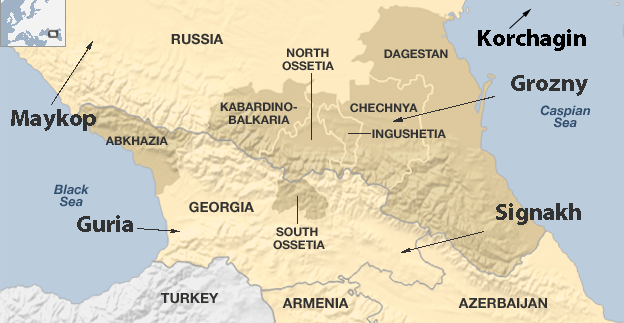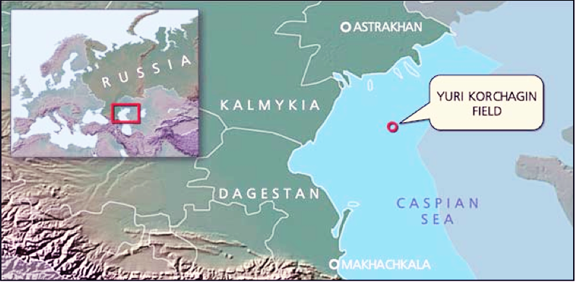Tech Talk - Oil Production from the North Caucasus
Posted by Heading Out on January 9, 2012 - 5:32pm
When the topic of Peak Oil is raised, one of the first responses often heard from those trying to explain why a peak isn't going to happen, at least in the short term, is that technology will come up with new answers. These innovations will allow greater production of oil through access to previously unavailable reservoirs, and an increase in the amount of oil that can be economically recovered from them. This is an argument that has had demonstrable success in the past. An earlier post showed that innovations in technology allowed the region around Baku in Azerbaijan to remain one of the centers of oil production since the time of the first Russian oil pipeline in 1878 through today. The argument is unfortunately not universally or ultimately true, but it does provide an introduction to today's topic.
The change from cable-tool drilling to rotary drilling resurrected production in the Caucasus after the Soviet Revolution. The growth of production, including the areas of the North Caucasus, also brought other fields on line. These were initially the fields around Grozny and Maykop, and in combination they raised production to around 622 kbd at the start of the Second World War. In more recent times, it is the introduction, once again, of the latest Western technology that has helped to sustain Azeri production, and new technology is starting to improve and sustain production in the North Caucasus.

Georgia, through the port at Batoum (now Batumi), was one of the early exporters of oil from Russia to Europe.
The production of the northern Caucasus increased from 100,000 poods in 1877 to 1,656,000 poods in 1889. In the latter year, Terek furnished 275,731 poods, Elisabetpol 3,000 poods, and Daghestan 3,955 poods, while in the Signakh field near Tiflia, 55,296 ppods were obtained.
Note: poods were the early Russian measure of production and there are 8.33 poods per barrel.
In the period from 1884 to 1914, Georgia exported a total of around 165 million barrels of oil. This oil increasingly came from the fields around Grozny (now in Chechnya, Russia) and later from the fields around Maykop (now in the Republic of Adygea in Russia), even though there were considerable signs of oil in Georgia (oil sands near Signakh west of Tbilisi and gilsonite in the Guria district). The Grozny fields were producing about 18% of Russian oil (with the rest coming from Baku) in 1915.
Following the collapse of oil production with the Revolution and the end of Western ownership, it was the use of rotary bits that allowed production to ramp back up, supplying a seventh of Western European imports (John Grace – Russian Oil Supply), and providing needed income to the Kremlin.
During the Second World War the region became a target for German occupation, given that oil from the region was providing a third of German imports in 1940 (Daniel Yergin – The Prize.) However, although Operation Blau reached Maykop, the smallest of the three main oil concentrations, the oil fields had been destroyed, so only around 70 barrels per day were left available. The German Army soon became bogged down in the siege of Stalingrad to the north and did not reach Baku.
The oilfields around Grozny were first developed in 1893 and grew steadily, with 386 wells by 1917. The Grozny field peaked at around 154 kbd in 1932, while the output from the entire Chechen-Ingushettia region, which fed to the three refineries at Grozny, fell to around 148 kbd by 1980 and to106 kbd by 1985. Grozny then became more of a pipeline terminal.
The first major pipeline running from Grozny to the refinery at the port of Tuapse, had been built in 1927. The pipeline was later extended to also pick up oil from the Maykop fields, and fell into disuse in 1968 when it was replaced with more modern pipelines to the rail terminals and oil terminal at Tikhoretsk, and that pipeline is now being increased in size to carry 250 kbd of oil. The terminal, which takes oil from the North Caucasus and Kazakhstan and forwards it to Novorossiysk, on the Black Sea, has a maximum throughput of 640 kbd overall. Part of the pipeline carried oil initially from Grozny to Baku, but with the onset of the Azeri-Chirag-Guneshli project, flow is now reversed.
Grozny has had an unfortunate history with the surface structures being largely destroyed, first in the Revolution and then by German bombers. The town and facilities were rebuilt and became the center of the local oil business. The Chechen wars of 1994-96 and 1999-2000 then largely destroyed the center of the city. Similarly the oil wells in the region were impacted; in the 1994 war only 100 wells, out of 1,500, were operating by the turn of the year.
The more recent finds, that are resurrecting the promise of the North Caucasus come, however, as do many recent discoveries, offshore. Lukoil carried out a series of explorations in the North Caspian between 1999 and 2005, finding six large fields off the Dagestan and Kalmykian coasts. These were Khvalynskoye, Yuri Korchagin (50 kbd) , Rakushechnoye, Samatskoye and Filanovsky. The fields were initially assessed at around 4.7 billion barrels of oil, with the Valdimir Filanovsky being claimed as the largest new oil reserve discovered in Russia in 20 years. The initial well flowed at 6,400 bd with reserves estimated at 600 million barrels, with 34 billion cu. m. of natural gas. Overall, North Caspian production was anticipated to peak in 2013 at 170 kbd, but Filanovsky alone, due on line in 2014, is now anticipated to reach 210 kbd with production initially coming from 11 directional wells with horizontal completions. To reach these levels Lukoil will be investing some $22 billion.

Looking further into the future, Lukoil is expecting to be able to further develop the North Caspian to reach a production capacity of 320 kbd of oil and 13 billion cu m of natural gas per year, by 2020. Lukoil expects that the increase in production will be able to offset declines that are anticipated from Western Siberia by that time.
The introduction of modern technology is thus helping to increase production from regions that were, at one time, thought to be exhausted. It should, however, be remembered that horizontal wells have now been around for some 30 years. One wonders what, so far unpublished, new technologies will appear to help within the decade, since to have an impact they must be widely accepted and adopted, and I don’t hear of much.





While this is a technical article, with a focus on drilling techniques, the meat of it seems to be that the North Caucasus has been unable to produce consistently, and has not be fully developed with these 30 year old "new" technologies, almost entirely due to political issues. Basically, oil production in this area depends very heavily on political stability.
This seems to be a common theme in many oil producing areas. Perhaps war is a greater threat to future oil production than even geology.
The real story here is the huge capital investment $22B in order to get only 300kb/day or 4.5B gallons of gas per year or enough for 9m cars.
That is about $2,400 investment per car just for the fuel infrastructure. Assuming distribution costs are zero that is about a 10 year payback with interest. If you add the investments required in roads and car production, the picture is less rosy for investors.
The window for new forms of transportation seems to be opening.
I read it as $22B to get 210k bpd.
OTOH, that's not bad: 210k bpd is 77M bpy, or about $7.7B in income at $100/b. That's about 35% $ROI.
On the 3rd hand, that says something about the enormous investments required for the normal functioning of the energy industry - this is very big business.
On the 4th hand, I agree that $100 oil definitely opens the door for alternatives. Heck, $2k will pay for enough windpower to power an EV for 25 years.
I believe that the $22 billion refers to the ongoing program, which includes all six fields plus continued exploration, with assumed continued success, since their numbers for production out to 2020 (320 kbd) will require more volume than appears possible from the existing discoveries and developments.
Korchagin is reported to have cost $1.4 billion for a production of 50 kbd, which is a better rate of return than you suggest. Filanovsky seems to be getting an investment of around $5 billion for the 210 kbd, which runs at at the same order of magnitude. They are looking at much higher investment as being needed to improve and sustain production in the future from both fields as well as finding additional places from which to get the extra volume.
"a better rate of return than you suggest" Less than 1 year payback?
And then there is the natural gas revenue, as well. It doesn't seem likely that any of this is financially marginal at present.
No doubt this particular project is a compelling investment. My point was that Asia is adding cars to the road faster than we can find these types of projects. The capex investments are ever increasing as it gets harder to find new fields.
The time is now to look for new forms of transportation.
Oh, I think we are way past seeming to open. Based on my visit to the local Nissan dealer yesterday, and previous test drives with other manufacturers, I would say we are there. Now if we can only get the price signals of peak oil to arrive in sufficient amplitude to convince others.
I find this map very useful to illustrate how complicated political issues in the Caucasus region can become. It shows areas of various ethnic groups.

http://www.youtube.com/watch?v=8zWMH2cVfGY
War for oil ain't nothin' new.
X,
I find that you are due a compliment in respect to your rapid progress as a spokesman for your own agenda.Keep it up, and if you lose the ethanol wars, you can get a job in PR someplace.;-)
(The best propaganda is always based on a kernel of truth, and I find that while I disagree with X about ethanol and corn, I agree with him on lots of other things, because he is generally right and selects good examples to further HIS argument-corn ethanol.)
Ethanol does indeed insulate us to some extent from oil dependency by allowing us to convert more plentiful and cheaper domestic coal, natural gas, wind, and hydro power into liquid motor fuel.But this does not outweigh the disadvantages associated with it, such as fossil water depletion, higher food prices, soil loss, and eventual depletion of coal and ng.
We need to focus on efficiency and conservation rather than feeding the automotive beast and helping it grow larger.
how exactly do we convert coal, natural gas, wind, and hydro power into ethanol?
We don't.
It's a metaphor (or a misunderstanding of a metaphor) which is intended to convey that ethanol doesn't have much more energy in it than is used to produce it.
We don't..
From a chemical engineering standpoint, if you want to create a liquid fuel from surplus electricity - something that could be very important if you have a lot of wind power and other renewables - you use the electricity to generate hydrogen, and use that hydrogen to create methanol from any feedstock containing carbon.
For instance, cellulose es effectively (CH2O)n, so the general reaction (H2)n + (CH2O)n = CH3OH (Methanol) is fairly simple. The fact that the end product has no C-C bonds makes it easier.
You can even use CO2 as a feedstock, for a completely closed-cycle operation 3H2 + CO2 = CH3OH + H2O. That's more energy intensive, though.
Methanol is typically used as a fuel in drag racing due to the extreme octane rating. It can also be used in fuel cells, even small versions for electric equipment such as laptops.
Have you seen good information on capital expenditures and efficiency for the H2 -> Methanol cycle?
That plus the fact that methanol is safer, in case of fire. Indy Cars also run on methanol.
I think some NASCAR races utilize ethanol ??? I asked a fan one time why they didn't burn methanol, his reaction was that they were not Stock Cars. It seems that restriction has been removed , for ethanol.
In the 70's - 80's car manufacturers in the US were working on developing cars to run on methanol. There was a surplus of NG back then too, mainly because long standing price controls were removed from NG produced for interstate sales.
"It is an argument that has had demonstrable success in the past."
Ingenious twist to call demented rationalization "an argument", and belief in it "success".
But just because "an argument" in mathematics must strictly conform to mathematical rules does not mean that it has to in drug addiction discussions I suppose. At least that is how it has been for generations.
I found a quote from 1944 that illustrates what I mean:
(Myth Addiction Is Establishment's LSD). Blood for oil is an old notion it would seem. So is propaganda for oil. Hey, ancient elder worship, gotta luv it.
It's inadvisable to drill the Caucasus until it's totally exhausted, hoping for a little more production. At least that's my experience.